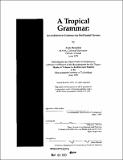A tropical grammar : an architectural grammar for hot humid climates
Author(s)
Beamish, Anne, 1954-
DownloadFull printable version (16.92Mb)
Alternative title
Architectural grammar for hot humid climates
Advisor
William J. Mitchell.
Terms of use
Metadata
Show full item recordAbstract
This thesis considers the viability of an architectural grammar based on traditional Caribbean architecture as an aid to designing climatically responsive architecture in hot humid climates. It argues that since traditional Caribbean architecture is a successful response to the constraints of climate and resources, a grammar based on this architecture would produce designs with similar characteristics and therefore would still be relevant today. The purpose of focusing on the relationship between architectural form and energy use is to help designers understand the consequences of basic design decisions and to help them to use these issues positively to generate form. In order to investigate this issue, a number of questions were addressed in the thesis. They were: What are shape grammars? What is appropriate design in hot humid climates? What is traditional Caribbean architecture and is it climatically appropriate? What would a tropical grammar look like and what would it produce? and How could it be used practically? A grammar was formulated based on a set of 16 traditional Caribbean houses and as a test, two new designs were generated. Shape grammars, in their most basic form, are essentially a set of rules that if followed, will generate designs in the same family as the original set. Typically, they are used to study a particular architect's style or occasionally a building style. This thesis states that shape grammars have two serious limitations which reduce their usefulness to designers. The first is that shape grammars focus only on physical form and the second is that they do not increase the user's understanding of the reasons for the grammar rules. However, it was found that, in contrast, the process of developing or formulating a grammar (as opposed to using one) was exceptionally useful for developing a deep understanding of the architectural style or type. The thesis concludes that architectural grammars can be a very useful and accessible tool for designers: 1. if they are able to go beyond physical form to include other architectural issues and knowledge; 2. if means are developed for presenting grammars which allow users to understand the rules, and not simply follow them; and 3. if methods are developed for analyzing and evaluating the designs that are generated by the grammar. It also concludes that a grammar is a useful tool to familiarize designers with the most successful characteristics of traditional architectural vocabulary. The purpose of this type of grammar is not to copy or duplicate a style, but to learn from its practical solutions in order to create new combinations of form that would be appropriate to the conditions found today.
Description
Thesis (M.S.)--Massachusetts Institute of Technology, Dept. of Architecture, 1993. Includes bibliographical references (p. 171-177).
Date issued
1993Department
Massachusetts Institute of Technology. Department of ArchitecturePublisher
Massachusetts Institute of Technology
Keywords
Architecture